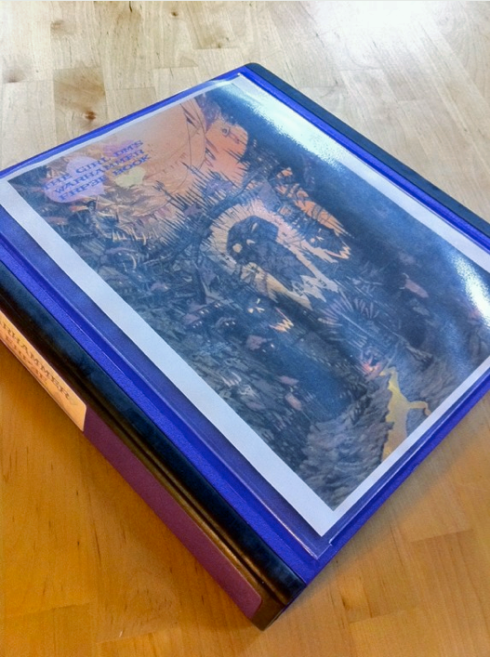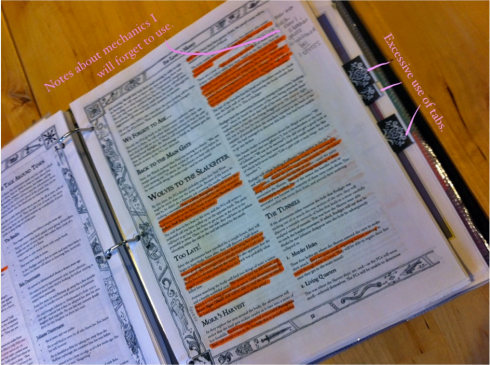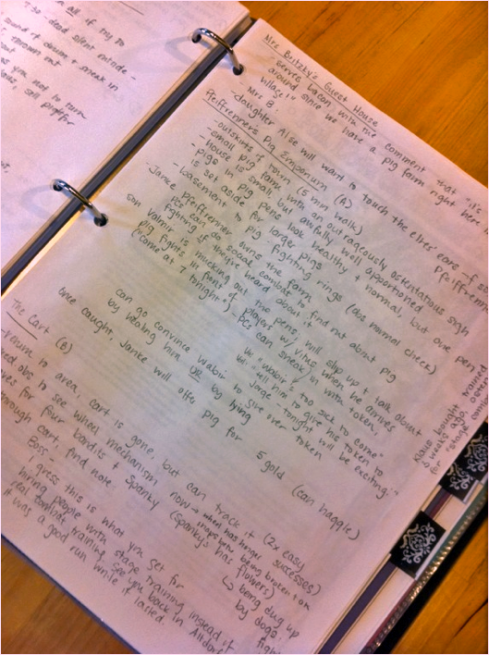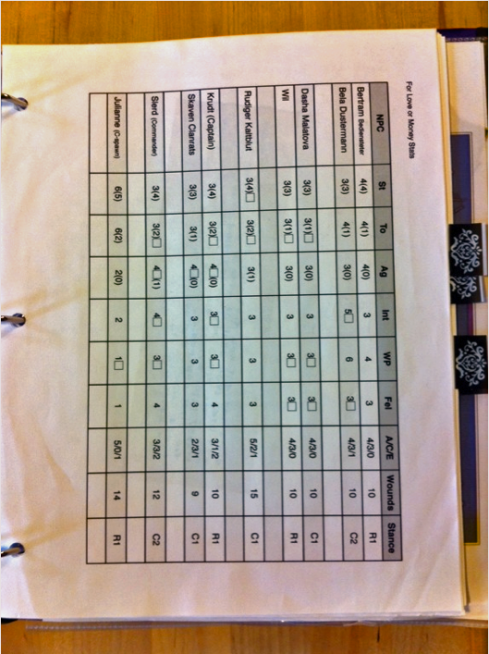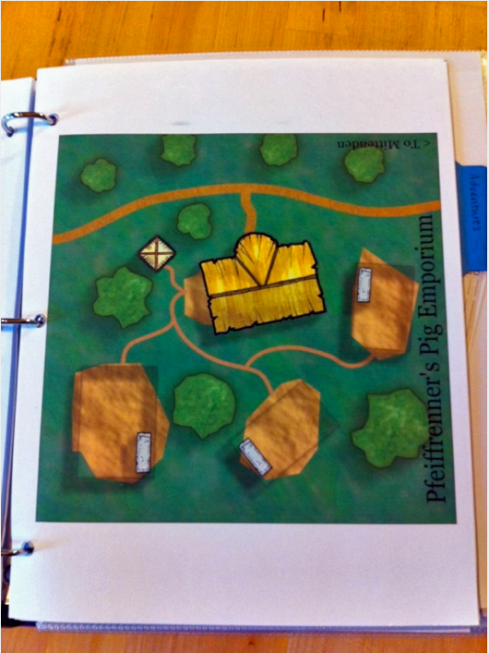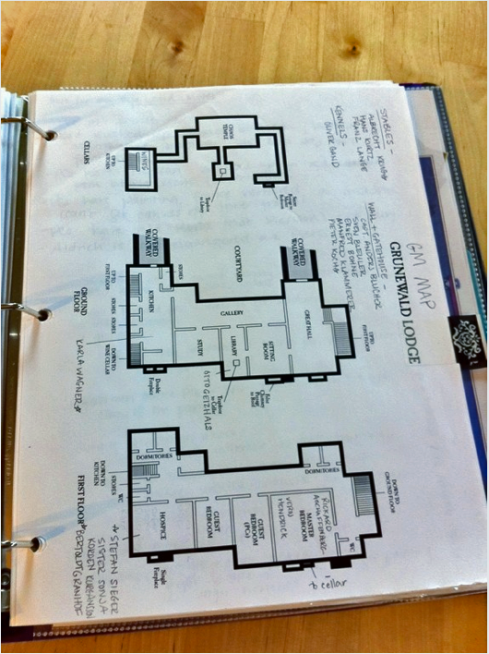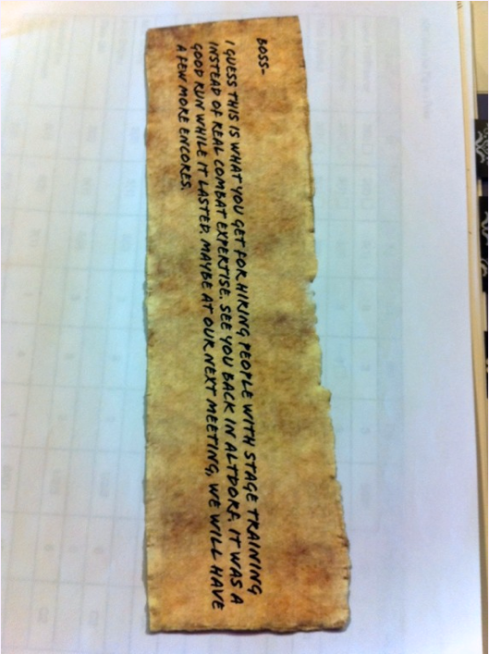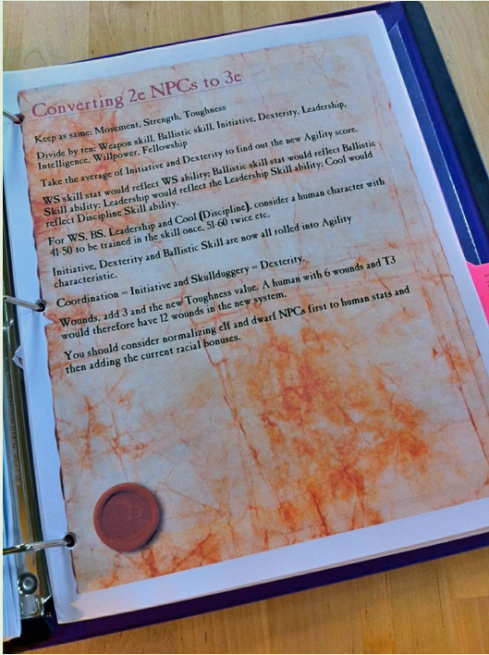You are currently browsing the category archive for the ‘How-To’ category.
I’ve used Storium for awhile now, playing in a handful of games and narrating a couple. While Storium norms are still in their early stages, I’d like to offer some preliminary ideas about what’s worked for me. Naturally, YMMV. After all, the background of player groups on Storium vary wildly; some come from RPG backgrounds, while others come from PbP games and still others from fanfic writing. Those player groups have different styles which work for them. That being said, though, here are some things that make sense to me.
Define the Level of Player Autonomy Before You Begin
Some Storium games are more collaborative than others. In two of the games in which I play, the narrators describe the setting and let us do whatever we please, creating situations within those spaces as we see fit. Those games are a little like free-form LARPs. In another game, the narrator expects players to take moves and wait for feedback about what the NPCs do and how the world changes in response; she’s got a scripted game and we play to find out what she’s written, much like a tabletop RPG. My own Warhammer game runs somewhere in the middle: I have a scripted idea of what’s happening on the largest level, and I tend to start scenes with strong direction from NPCs. Yet I have invited my players to speak for NPCs, add events, and complicate scenes as they see fit.
Not all narrators are comfortable with the same level of player input, and the same goes for players. Advertising your expectations clearly and reinforcing those expectations early on makes for better game play, as everyone knows what types of moves are expected and allowed. Can players speak for NPCs? Can players drastically change the plotline? Can they solve problems with magic or other mechanics you haven’t explicitly introduced?
Where you fall on this scale will drastically change how you approach planning for and responding to your game. If you’re going to ask players to wait for your feedback, you’ll need to check your account and respond often so that players aren’t sitting and waiting on you to tell them what an NPC thinks or how a magic spell worked. You’ll also have to have a clear sense of what’s happening in your world. If, on the other hand, you mean to allow players to alter the course of events and speak for NPCs, you’ll need to roll with the punches and be willing to change your story–perhaps drastically–at the drop of a hat, perhaps re-envisioning your main characters through the lens of the players’ understanding of them.
Personally, I’ve had a great time rolling with the punches. The beauty of Storium is that you don’t have to respond right away like you do in a tabletop game; I can see what my players have said, mull it over for awhile, and come back to them with something that suits them. At one point, for instance, my players were infiltrating a cult of Nurgle. In the Commentary section, one of my players made a crack about wanting “balloons” in the scene. I had originally planned a fairly straightforward cult, but the balloons idea resonated with me, and I crafted a whole scene around a Nurglish birthday party ritual. It’s some of the most fun I’ve had in a game, and it was great to have the opportunity to respond to a player idea (even if it was just a jest!)
Use the Commentary Section
As a narrator, I’ve found the commentary section invaluable. It’s the best tool you have for explaining the expectations you have about player behavior in a given scene, about a piece of lore, or about how you want players to use the mechanics. If you’re a player, it’s a great place to ask questions.
In my Warhammer game, there’s one NPC I don’t want the players to speak for; he’s been in a couple of my Warhammer games, and I have a very clear sense of his character. Plus, he’s incredibly powerful, and putting his power in the hands of my players might unbalance the game. So what did I do? I used the comments at the first mention of his name to let them know that I didn’t want them to speak for this particular NPC. I reminded them when I introduced the next NPC that they could speak for him–just to reinforce the overriding expectation in my game–but the Commentary gave me a great place to underscore the one exception that proved the rule.
In another game in which I play, my narrator had a dangerous NPC lock us in a room after storming out. A challenge card for her character remained, though. I wanted to know if he was envisioning the challenge associated with that NPC as being “gone” since she wasn’t in the room, or whether I could still play cards on her challenge and count those cards as representing our making a plan to overcome her when she came back. The Commentary gave me the perfect space to ask about his understanding of the rules and let us discuss it before I made my move.
Give Players a Focus
If everyone in the group has a strong LARP background, a clear focus might not matter, as players can entertain themselves through RPing with one another. In most groups, though, games tend to grind to a halt when players aren’t sure what to do, and challenge cards don’t always give quite enough direction. In your main narration, keep the tension high. Give your players a problem to solve or an impending threat to overcome. Make it clear, present, and obvious. Is that thing about to explode? Is someone ill? Are guards on the way? Is there a monster outside? Books don’t quite work like this–not every scene is high-tension. But writing games often should work this way, just to give players a sense of urgency about their moves.
If you want a pure RP or planning scene, first, use the Commentary to make sure the players know your plan. Second, give them a good backdrop for their RP. Add in some entertaining scenery, an animal or child, or a shiny object. If the conversation flags, the players can pick up on the background cues to keep things moving. Use those props to give information about your game world. If you want to give hints about what’s to come without having an NPC tell the players too much, put it in the scenery and let the players discover it. Just don’t cover the important detail with so much verbiage that they miss it!
Use the Mechanics Only When They Suit
Currently, there are some odd things about Storium mechanics. For instance, settings can never be challenges, but NPCs are always challenges. Roll with these punches, too, and only use challenges when there’s really a challenge to overcome. Generally speaking, I introduce the NPCs and setting (usually at the end of the previous scene) and let things heat up before I throw out a challenge card to open the next scene. That gives me a chance to know where the players want to direct their attention. If the players enter the catacombs and ask questions of the head cult member, that’s a cue to me to throw out an NPC challenge that relates to him. If, on the other hand, they enter the catacombs and immediately take interest in the bodies buried there, that’s an obstacle challenge that represents their investigation, and I might never use an NPC card for that cult leader at all.
For me, NPC challenges tend to represent persuading or incapacitating. Obstacles represent anything else.
Define Outcomes Creatively
It’s tempting to give your challenges yes/no outcomes: if the challenge is completed successfully, you kill the monster; if not, you don’t. It doesn’t have to be that simple, though. First, you might want to give your players more autonomy. What if they want to know something about the monster that they can’t find out if they chop off its head? You might have a successful outcome be “if the challenge is completed successfully, you kill OR incapacitate the monster.” Now they can choose. I use many EITHER/OR outcomes in my challenges to give players choice.
At other times, you might offer players degrees of the same choice. Right now, there’s an NPC in one of my scenes that I don’t want killed. He’s being a pain in my players’ asses, but I just don’t want them to kill him. Still, they should have the chance to do something to take his questionable behavior down a notch. My outcomes for his NPC challenge look something like this: SUCCESSFUL: you quiet him down and keep him happy. UNSUCCESSFUL: he’s still here, but he’s freaking out and will be less easy to control in the future. There’s still a choice about how much effort they want to put into making this NPC calm, but the outcomes aren’t quite as drastic as dead/alive.
Finally, think about uncertain outcomes. When players hit an uncertain outcome, I tend to think of it as a chance to give information without moving the story substantively forward or backward. Let’s say the players have a challenge to climb a mountain that looks unstable; their outcome on that challenge winds up uncertain. I might tell them that they think they could do it successfully with rope (which they don’t have,) adding a further complication to find rope. Or I might tell them that it looks so unstable that they wouldn’t climb it until the rain stops, then give them a challenge relating to killing time or keeping dry until the rain stopped if they wanted to give the challenge another shot. For NPC outcomes, it’s a bit easier: they don’t impress or upset the NPC, but the NPC tells them something they didn’t yet know.
Reward Player Cues
Hopefully, you have players who read carefully and pick up on the little details in your prose. If so, reward them by returning the favor. If they describe a particularly interesting bit of their character’s clothing, let an NPC notice it–perhaps it’s how the guards recognize that PC later on. If they bring up a relationship with a character who isn’t a PC, bring that character in as an NPC and let them have some meaningful interaction with her. Not only will you keep your players engaged, but you’ll also encourage them to read your text more carefully and use your details creatively.
When playing, do the same. There’s nothing more rewarding to me as a narrator than seeing someone run with one of my little details and turn it into a bigger part of the game. Tell your narrator which parts of the game interest you; encourage her to give you more of that. That’s not to say that you should ignore the things your narrator has staked out as major plot events, but interacting with the details you find intriguing is a useful form of feedback for your narrator.
Hopefully these thoughts will help others as they hash through their own preferences and playstyles as both narrators and players. I’ve had a great time with Storium thus far, and I hope that others will keep telling awesome stories with it!
If you’re a member of Storium, stop by and visit my Warhammer game! Click here.
Time passes.
My husband and I raced in the Run for your Lives zombie 5k this weekend. It was largely a good experience, except for the terrible waiting at the parking lot. The race producers had decided to set up a shuttle bus to take people from there to the main site. Cars got stuck in the mud on the way to park, the race had too few buses, there were long lines, and people had time to get grumpy–and to let that grumpiness bounce off of the grumpiness of others and multiply– before they got to the part of the race that had been done well. Unfortunately, the same experience on the way back out meant that a largely positive race experience was bookended by two unpleasant experiences. The result? A lot of needlessly unhappy racers.
As most things do, it got me thinking about games. I’ve generally been most unhappy at gaming tables where the GM forced us to sit through lots of downtime. Everyone needs to look up a rule or adjust a scene at some point, but some GMs do that much more gracefully than others. The right group will chat through downtime and have a good time–but even that will often be out of character and detract from the game. At my own table, moments of forced downtime tend to mean that everyone checks Facebook on his iPhone; God help me if someone has posted a funny internet meme, because then the players pass the phone around the table and talk about the hilarious duck dressed as a fire hydrant for the next ten minutes. Even at conventions, though, where people tend not to feel comfortable enough to check phones, downtime leads to some weird staring at one another.
What to do, then?
First, see if you can’t look through the scenario before you run it and find the places that will require downtime. Will you need to change the scenery on the table? Is there a big battle that will require you to set out lists of NPC stats behind your screen? Is there a moment in town that’s likely to split the party so that some players are sitting with nothing to do while others are going about their PCs’ personal business? Does a scene highlight the skills of one or two characters for an extended amount of time, leaving the others with nothing to do?
I’ve already handled some ideas for what to do while changing scenery, but if you can always give the players some long-term tasks to work on in moments when they’re not directly engaged with the GM or the plot. Here are some ideas for things they can work on during downtime:
- Make a code for them to work out. You might work your code into the story so they must solve it when you hand it out, but you can also have the code remain a task in the background. They can pull out and decode it when you’re setting up or others are taking their turns in town. The easiest codes are made just by typing something into your word processor, selecting all, and then choosing one of those picture fonts on your computer, like Wingdings; players can figure out how the substitution works from the letter patterns. If you want more challenging types of codes, you can use internet code makers like this one.
- Ask them to map the area through which they’re traveling, then have them do it. Other ‘produce it during downtime’ moments might be asking them to write and sing a song or draw a commissioned portrait of a particular NPC. Not all groups will go for this type of interaction, but you might try it–you’d be surprised at what your players might enjoy.
- If in town, have PCs work on individual character development by planning any letters they might send to acquaintances, key contacts, family members, etc., while waiting on the others to take their interactive turns. They can either describe these to the group, or just jot down the ideas and give them to you as future plot hooks.
- Ask those not in the spotlight to plan actively for the upcoming battle/negotiation. Sometimes players will sit and wait until things are “in the moment” to decide what to do, but if you don’t mind a bit of meta table chatter, you can listen and get a sense of what they’d like to see in an upcoming scene.
Downtime at the beginning and end of the game remains the most crucial. If you want your players to take the narrative space of the world seriously, easing them into and out of the game helps them focus and get ready for the tasks to come. Personally, I like Burning Wheel’s Beliefs, Goals, and Instincts for this purpose. (Yes, I know! I sound like a broken record on this one. But they’re really good mechanically.) If you don’t want to focus that heavily on individual characters, though, you can still start by having one player recap the last session; it’s a good idea to tie a reward to the recap or to require that a different player recap the session at the beginning of each game. Otherwise, the task can fall to the same note-taking player over and over again. You might also want to give the players a moment to lay out some group goals for the game ahead. (If you’re playing WFRP3e, this might be a time to review the standings of Party Tension with the group.) You might even just start with a check-in: “How does your character feel right now as we begin the day? What do the others see as they look at him/her?”
At the end of the game, you’ll benefit by doing much the same. Ask how each character feels now, and get a sense of what his/her goals will be in the upcoming play session. That way, you’ll be able to consider each player’s hopes for the next session as you plan it.
Most importantly, each player will feel as though his time at the table has been used well, and will remember that he had the spotlight at least once or twice during the game. If you can manage that, you’ll generally have players who feel as though their pastime has been a good use of their day.

So, that game I said I wasn’t going to order (but obviously did) arrived today. So there’s that.
Also, Monday marked my first venture into GMing Mouse Guard. I was a little fussbudgety going in because I wasn’t sure if I could keep my wits about me as much as Mouse Guard requires. I generally allay my fears by prepping copiously, but found that my trusty technique didn’t really fly for MG. With only a couple of plot points written ahead of time because the game aims to be so responsive to player innovation, the prewritten material didn’t lend itself to needing a whole host of cardboard buildings or excessive highlighting/notetaking. Even my plan to pull pictures for my iPad failed, largely because I couldn’t find naturescapes with tiny mouse buildings in them. Go figure. I pulled a couple of atmospheric pictures, but they seemed so irrelevant to the feel of the game that I ultimately gave up that approach.
After a half hour of wandering around disconsolately with the rule book, I decided to make some player kits.
We are as enthusiastic about our board games as we are about our RPGs–and just as obsessive about the stuff that comes in them. As you can imagine, our place has a whole drawer full of multi-sized baggies to help organize all of the bits from each game. We separate what each player needs at the game’s start out into player kits, which speed up the beginning of the game. (This is totally normal where we come from. Believe me.) Here, for instance, is the player kit for my team in the new Blood Bowl card game:

There’s everything you need to crush the opposing teams in one handy baggie!
With idle hands and nervous energy, I decided apply the same principle to my Guardmice. I went onto the excellent Burning Wiki section dedicated to MG and downloaded the character sheets for the premade characters, deleting the prewritten Session Goals because I wanted my players to create their own. Then I either downloaded or typed up descriptions of each mouse’s starting city so that my players had a better sense of where their mice originated so their backgrounds could inform their RP.

Finally, I made copies of those awesome flow charts, too, just in case, although we didn’t find ourselves using them. I packed all of that into a clear plastic page protector, and, of course, pulled out my bag o’ mechanical pencils.

It’s not the kind of prep I’m used to, but I finally felt like I’d done my “homework,” so I could relax a bit and feel ready to go.
As for the actual game play, it seemed to go well. We had quite a bit of party tension; one mouse wanted to slip away from the party to go get revenge against a former friend who had wronged her, but her Patrol Leader wouldn’t let her out of his sight because he wanted to keep her safe. It led to some interesting tension, especially when the other two mice decided to let them fight it out and deal with the main mission head-on with rope. (When it comes right down to it, most things in RPGs can be tackled with rope.) It does seem easier in MG to split the party than in other games, because so much relies on the players just talking out their decisions; while the GM resolves one set of checks, the other team can be talking out what they want to do. Our group really enjoyed the social combat rules, having a really great time thinking up direct points, rebuttals, and confusing errata to represent their Attacks, Defends, and Feints. I let them down on combat a bit; it was our first major conflict, so I focused too much on the rules, leaving them feeling like there was no RP to combat, when in fact, I was just trying to make sure everyone knew how the order of events went. Sill, you live and learn. They seemed to enjoy learning that they had far more power to negotiate about what the world was like, but were, as I predicted, a bit nonplussed by the fact that there wasn’t as deep of a prewritten story to follow or as many premeditated puzzles/challenges to “get right.” I suppose that ultimately, I could remedy either of these in subsequent sessions, should they choose to give it another go.
Given that we’ve played WFRP for so long, they were right at home with the cards in the MG Box Set, and remarked several times on the charming illustrations and the high production value. It seemed completely worth it to have the additional pieces since it gave this far more abstract game a bit of an anchor for my players.
Overall, it was fun for me to see the group work together in a different way, and I enjoyed the experience of more free-form GMing. I may try to GM a Mouse Guard game at a convention at some point. After all, there are so many possible ways I could make newbie-friendly player kits for a convention!

